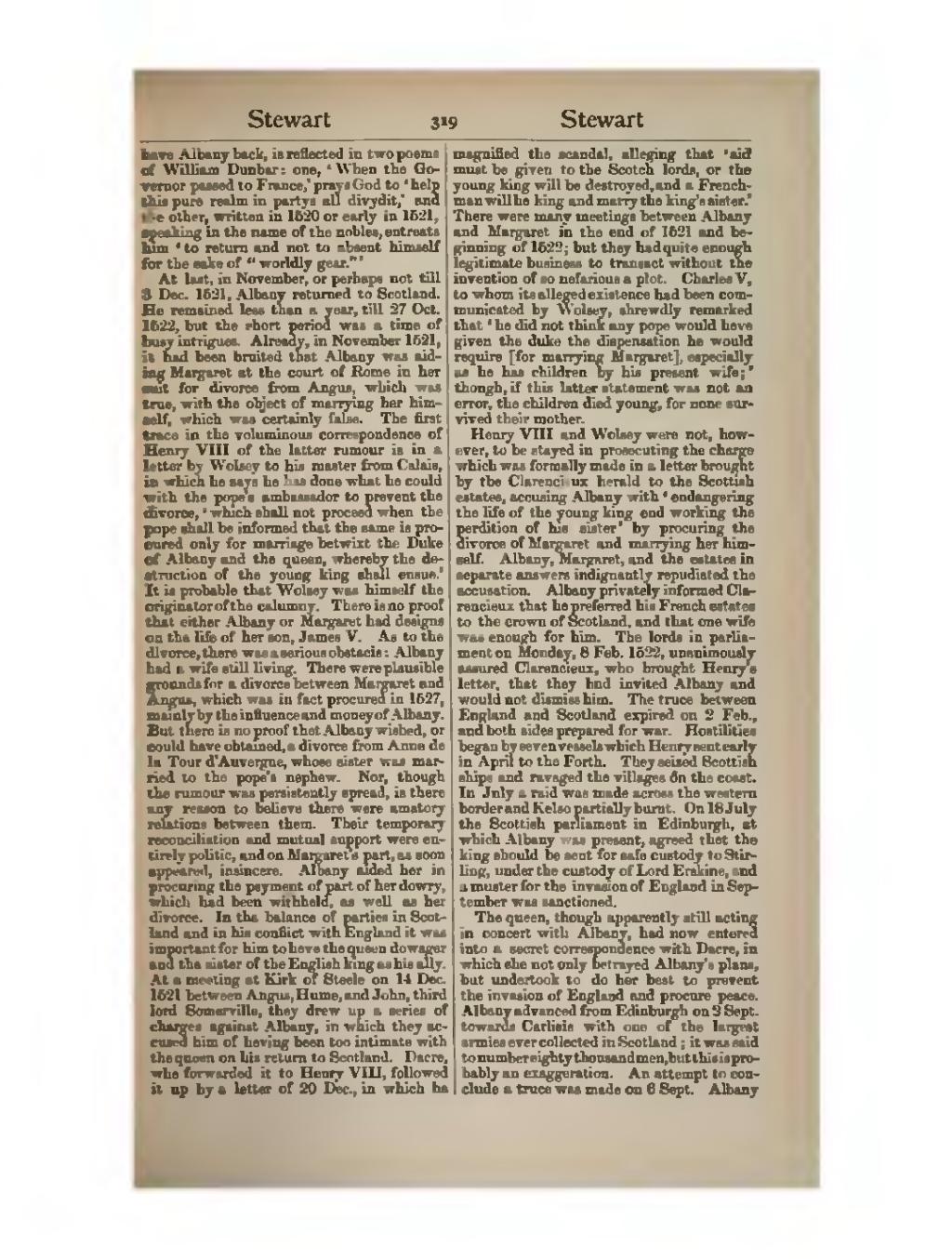have Albany back, is reflected in two poems of William Dunbar: one, ‘When the Governor passed to France,’ prays God to ‘help this pure realm in partys all divydit,’ and the other, written in 1520 or early in 1521, speaking in the name of the nobles, entreats him ‘to return and not to absent himself for the sake of “worldly gear.”’
At last, in November, or perhaps not till 3 Dec. 1521, Albany returned to Scotland. He remained less than a year, till 27 Oct. 1522, but the short period was a time of busy intrigues. Already, in November 1521, it had been bruited that Albany was aiding Margaret at the court of Rome in her suit for divorce from Angus, which was true, with the object of marrying her himself, which was certainly false. The first trace in the voluminous correspondence of Henry VIII of the latter rumour is in a letter by Wolsey to his master from Calais, in which he says he has done what he could with the pope's ambassador to prevent the divorce, ‘which shall not proceed when the pope shall be informed that the same is procured only for marriage betwixt the Duke of Albany and the queen, whereby the destruction of the young king shall ensue.’ It is probable that Wolsey was himself the originator of the calumny. There is no proof that either Albany or Margaret had designs on the life of her son, James V. As to the divorce, there was a serious obstacle: Albany had a wife still living. There were plausible grounds for a divorce between Margaret and Angus, which was in fact procured in 1527, mainly by the influence and money of Albany. But there is no proof that Albany wished, or could have obtained, a divorce from Anne de la Tour d'Auvergne, whose sister was married to the pope's nephew. Nor, though the rumour was persistently spread, is there any reason to believe there were amatory relations between them. Their temporary reconciliation and mutual support were entirely politic, and on Margaret's part, as soon appeared, insincere. Albany aided her in procuring the payment of part of her dowry, which had been withheld, as well as her divorce. In the balance of parties in Scotland and in his conflict with England it was important for him to have the queen dowager and the sister of the English king as his ally. At a meeting at Kirk of Steele on 14 Dec. 1521 between Angus, Hume, and John, third lord Somerville, they drew up a series of charges against Albany, in which they accused him of having been too intimate with the queen on his return to Scotland. Dacre, who forwarded it to Henry VIII, followed it up by a letter of 20 Dec., in which he magnified the scandal, alleging that ‘aid must be given to the Scotch lords, or the young king will be destroyed, and a Frenchman will be king and marry the king's sister.’ There were many meetings between Albany and Margaret in the end of 1521 and beginning of 1522; but they had quite enough legitimate business to transact without the invention of so nefarious a plot. Charles V, to whom its alleged existence had been communicated by Wolsey, shrewdly remarked that ‘he did not think any pope would have given the duke the dispensation he would require [for marrying Margaret], especially as he has children by his present wife;’ though, if this latter statement was not an error, the children died young, for none survived their mother.
Henry VIII and Wolsey were not, however, to be stayed in prosecuting the charge which was formally made in a letter brought by the Clarencieux herald to the Scottish estates, accusing Albany with ‘endangering the life of the young king and working the perdition of his sister’ by procuring the divorce of Margaret and marrying her himself. Albany, Margaret, and the estates in separate answers indignantly repudiated the accusation. Albany privately informed Clarencieux that he preferred his French estates to the crown of Scotland, and that one wife was enough for him. The lords in parliament on Monday, 8 Feb. 1522, unanimously assured Clarencieux, who brought Henry's letter, that they had invited Albany and would not dismiss him. The truce between England and Scotland expired on 2 Feb., and both sides prepared for war. Hostilities began by seven vessels which Henry sent early in April to the Forth. They seized Scottish ships and ravaged the villages on the coast. In July a raid was made across the western border and Kelso partially burnt. On 18 July the Scottish parliament in Edinburgh, at which Albany was present, agreed that the king should be sent for safe custody to Stirling, under the custody of Lord Erskine, and a muster for the invasion of England in September was sanctioned.
The queen, though apparently still acting in concert with Albany, had now entered into a secret correspondence with Dacre, in which she not only betrayed Albany's plans, but undertook to do her best to prevent the invasion of England and procure peace. Albany advanced from Edinburgh on 2 Sept. towards Carlisle with one of the largest armies ever collected in Scotland; it was said to number eighty thousand men, but this is probably an exaggeration. An attempt to conclude a truce was made on 6 Sept. Albany
